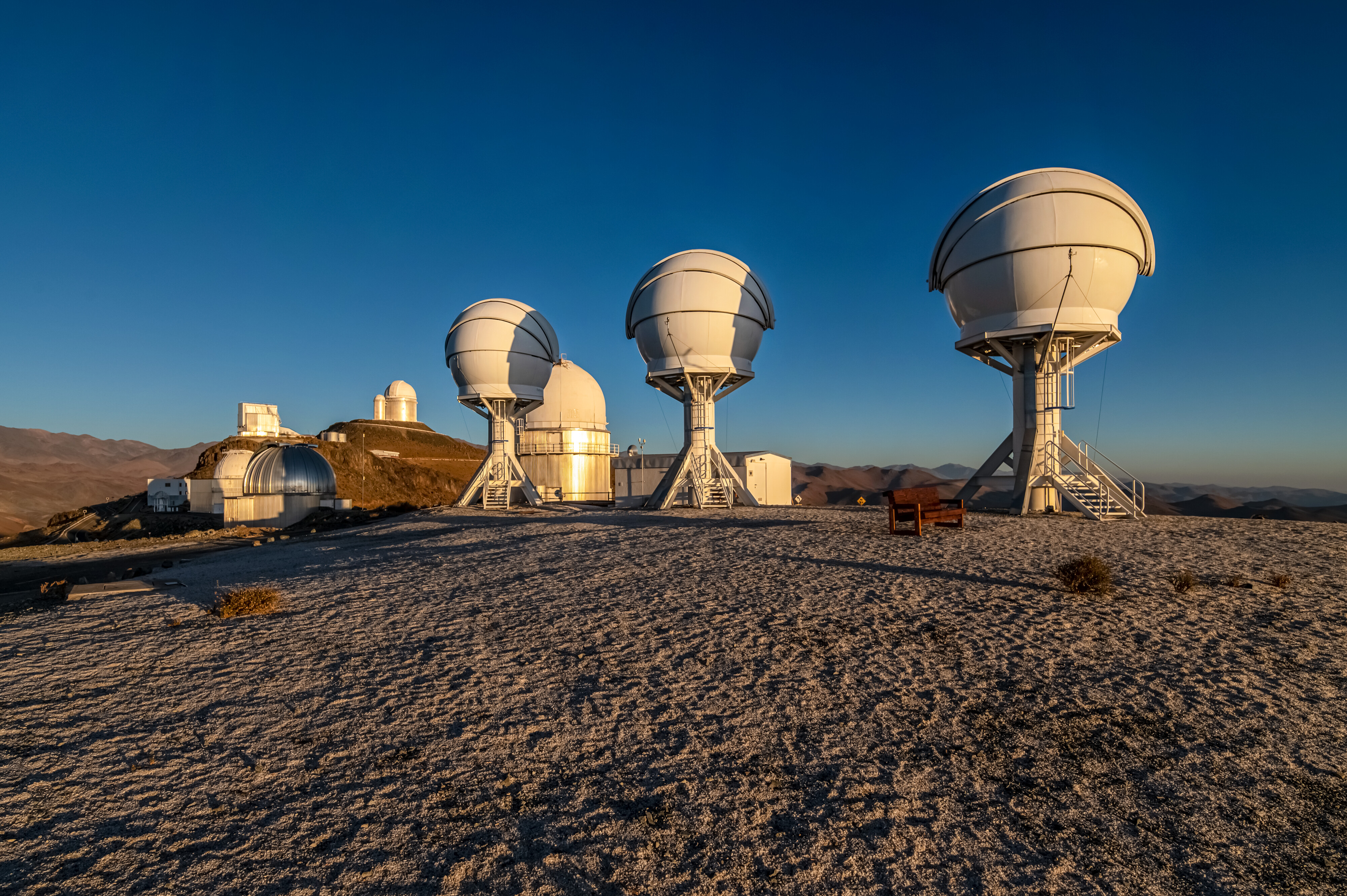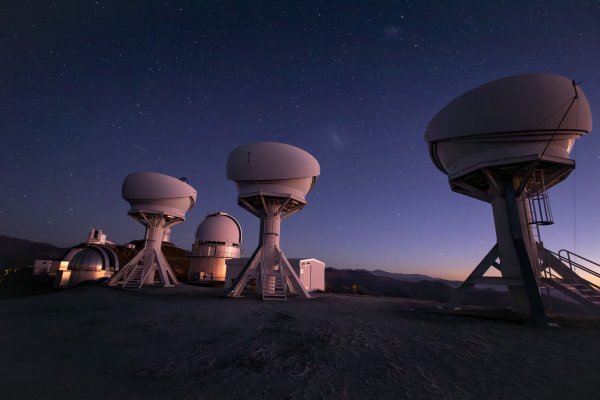The BlackGEM array, consisting of three new telescopes located at ESO’s La Silla Observatory, has begun operations. The telescopes will scan the southern sky to hunt down the cosmic events that produce gravitational waves, such as the mergers of neutron stars and black holes.
Some cataclysmic events in the Universe, such as the collision of black holes or neutron stars, create gravitational waves, ripples in the structure of time and space. Observatories like the Laser Interferometer Gravitational-Wave Observatory (LIGO) and the Virgo Interferometer are designed to detect these ripples. But they cannot pinpoint their origin very accurately nor see the fleeting light that results from the collisions between neutron stars and black holes. BlackGEM is dedicated to quickly scanning large areas of the sky to precisely hunt down gravitational-wave sources using visible light.
“With BlackGEM we aim to scale up the study of cosmic events with both gravitational waves and visible light,” says Paul Groot of Radboud University in the Netherlands, the project’s Principal Investigator. “The combination of the two tells us much more about these events than just one or the other.”
By detecting both gravitational waves and their visible counterparts, astronomers can confirm the nature of gravitational-wave sources and determine their precise locations. Using visible light also allows for detailed observations of the processes that occur in these mergers, such as the formation of heavy elements like gold and platinum.
To date, however, only one visible counterpart to a gravitational-wave source has ever been detected. Furthermore, even the most advanced gravitational-wave detectors such as LIGO or Virgo cannot precisely identify their sources; at best, they can narrow the location of a source down to an area of approximately 400 full moons in the sky. BlackGEM will efficiently scan such large regions at high enough resolution to consistently locate gravitational-wave sources using visible light.
BlackGEM’s three constituent telescopes were built by a consortium of universities: Radboud University, the Netherlands Research School for Astronomy, and KU Leuven in Belgium. The telescopes are each 65 centimetres in diameter and can investigate different areas of the sky simultaneously; the collaboration eventually aims to expand the array to 15 telescopes, improving its scanning coverage even more. BlackGEM is hosted at ESO’s La Silla Observatory in Chile, making it the first array of its kind in the southern hemisphere.

“Despite the modest 65-centimetre primary mirror, we go as deep as some projects with much bigger mirrors, because we take full advantage of the excellent observing conditions at La Silla,” says Groot.
Once BlackGEM precisely identifies a source of gravitational waves, larger telescopes such as ESO’s Very Large Telescope or the future ESO Extremely Large Telescope can carry out detailed follow-up observations, which will help to shed light on some of the most extreme events in the cosmos.
In addition to its search for the optical counterparts to gravitational waves, BlackGEM will also perform surveys of the southern sky. Its operations are fully automated, meaning the array can quickly find and observe ‘transient’ astronomical events, which appear suddenly and quickly fade out of view. This will give astronomers deeper insight into short-lived astronomical phenomena such as supernovae, the huge explosions that mark the end of a massive star’s life.
“BlackGEM is opening a new window for time-domain astronomy in Southern Hemisphere,” says Nadejda Blagorodnova, researcher at the Institute of Cosmos Sciences of the University of Barcelona and the Institute of Space Studies of Catalonia (ICCUB-IEEC), who is taking part on the project. “It will allow us to search for light emitted by gravitational wave events. It will also closely monitor a large number of nearby galaxies, which means that if any supernova or stellar merger occurs there, we will be able to find it almost in real-time and possibly identify its progenitor system!”
More information
The BlackGEM consortium comprises: NOVA (Netherlands Research School for Astronomy, the national Dutch alliance in astronomy between the University of Amsterdam, University of Groningen, Leiden University, and Radboud University); Radboud University, the Netherlands; KU Leuven, Belgium; the Weizmann Institute, the Hebrew University of Jerusalem and Tel Aviv University, Israel; the University of Manchester and the Armagh Observatory and Planetarium, UK; Texas Tech University, the University of California at Davis and the Las Cumbres Observatory, USA; the University of Potsdam, Germany; the Danish Technical University, Denmark; the Institute of Cosmos Sciences of the University of Barcelona, Spain; and the University of Valparaíso, Chile.
The European Southern Observatory (ESO) enables scientists worldwide to discover the secrets of the Universe for the benefit of all. We design, build and operate world-class observatories on the ground — which astronomers use to tackle exciting questions and spread the fascination of astronomy — and promote international collaboration in astronomy. Established as an intergovernmental organisation in 1962, today ESO is supported by 16 Member States (Austria, Belgium, the Czech Republic, Denmark, France, Finland, Germany, Ireland, Italy, the Netherlands, Poland, Portugal, Spain, Sweden, Switzerland and the United Kingdom), along with the host state of Chile and with Australia as a Strategic Partner. ESO’s headquarters and its visitor centre and planetarium, the ESO Supernova, are located close to Munich in Germany, while the Chilean Atacama Desert, a marvellous place with unique conditions to observe the sky, hosts our telescopes. ESO operates three observing sites: La Silla, Paranal and Chajnantor. At Paranal, ESO operates the Very Large Telescope and its Very Large Telescope Interferometer, as well as survey telescopes such as VISTA. Also at Paranal ESO will host and operate the Cherenkov Telescope Array South, the world’s largest and most sensitive gamma-ray observatory. Together with international partners, ESO operates ALMA on Chajnantor, a facility that observes the skies in the millimetre and submillimetre range. At Cerro Armazones, near Paranal, we are building “the world’s biggest eye on the sky” — ESO’s Extremely Large Telescope. From our offices in Santiago, Chile we support our operations in the country and engage with Chilean partners and society.



